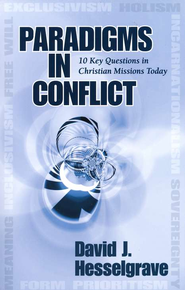David J. Hesselgrave: Paradigms in Conflict
 David J. Hesselgrave, Paradigms in Conflict: 10 Key Questions in Christian Missions Today (Grand Rapids: Kregel, 2005), 368 pages, ISBN 9780825427701.
David J. Hesselgrave, Paradigms in Conflict: 10 Key Questions in Christian Missions Today (Grand Rapids: Kregel, 2005), 368 pages, ISBN 9780825427701.
It is rare to find a very readable and theologically sound volume that examines current missiological issues perceptively with historical backgrounds, biblical exegesis, and practical insight by a recognized giant in the field. David Hesselgrave covers ten key topics such as sovereignty and free will, whether one can be saved without hearing the gospel and trusting Christ, whether common ground is possible to find with other religions, holism and prioritism, the missionary models of Christ and Paul, spiritual warfare, the essence of a missionary “call,” contextualization, prophetic alerts, and the real purpose of missions. The volume has forewords by both Ralph Winter and Andreas Köstenberger.
Each chapter runs about 35 pages and is interesting, readable, informative, thought provoking, and practical. The issues are as the title suggests–key. Each deals with seminal truths. Hesselgrave believes and applies the inerrancy of the Scriptures. Twelve illustrations dot the book, including a chart demonstrating four ministries of the Holy Spirit in missions (p. 193). Each chapter includes a bibliography averaging about thirty important recent sources, including periodical articles. Hesselgrave is fully abreast of the thinking on each topic and explains why each is so vital to understanding and accomplishing the true task of the Great Commission. In citing the history of the modern missions movement, Hesselgrave is not afraid to critique friend and foe alike, but with a kind and gentle spirit. He chides the downward drift in the World Council of Churches’ missions programs and warns of similar slides in current movements. He discusses Kraft’s contextualization and the TNIV, concluding that both do damage to “the verbal-plenary understanding of revelation and inspiration.” Hesselgrave agrees with Alva McClain and Robert Culver on the meaning and purpose of church, kingdom, Scripture, and mission, and contrasts that with the mistaken views of George Ladd, James Engel and William Dyrness. The volume also contains a helpful nine page subject index and a three page Scripture index.
On the issue of common ground, Hesselgrave notes that most, if not all, of the similarities between Christianity and other religions are too flimsy and not true parallels. For example, “The Allah of the Qur’an is very unlike the Triune God of the Bible” (p. 99). The only real common ground is that all people in every culture are sinners. One of the bluntest statements Hesselgrave makes, after a search for common ground in other religions is, “Perry is right when he avers that the various religions represent ways in which humankind is being led away from God, not toward him” (p. 102). He adds, “Dissimilarities may in fact prove to be more useful than similarities in communicating Christ and the gospel. This often is the way that new knowledge and understanding are attained. After all, the Christian faith (in its revelation if not always in its practice) is absolutely unique. There is no other faith like it” (p. 105).
Regarding the common ground of sin, Hesselgrave points out that all of us are sinners before a holy God. “That is the common ground on which both Christian missionaries and their non-Christian hearers stand. We must not only admit it; we must insist upon it. If there is any one key that unlocks the door to common ground it is ‘missionary self-exposure.’ … So sin and sinnerhood can and must be explained. But how much easier to understand if they are permitted actually to see a sinner” (pp. 111-112).
Category: Ministry, Pneuma Review, Spring 2007


